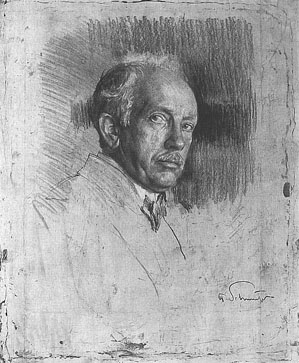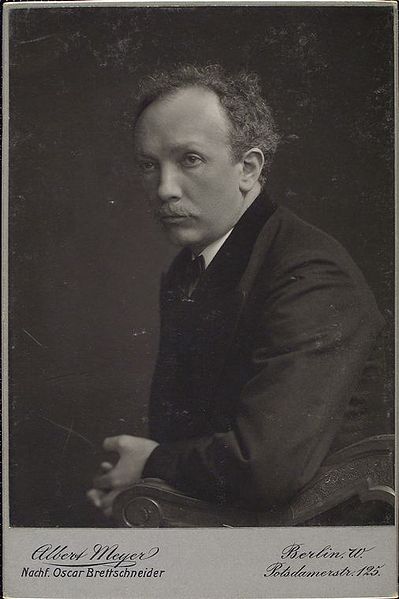<Back to Index>
- Composer Richard Georg Strauss, 1864
PAGE SPONSOR
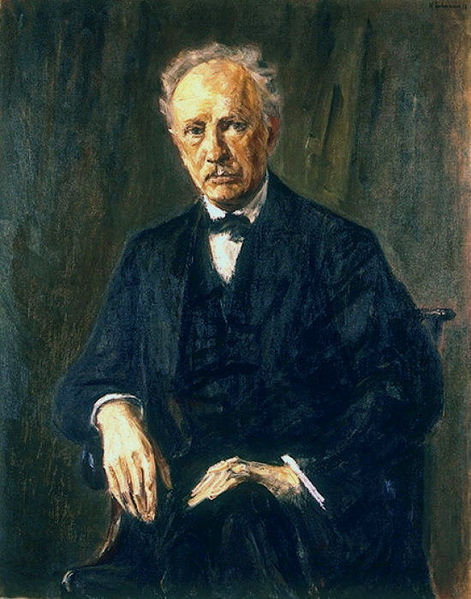
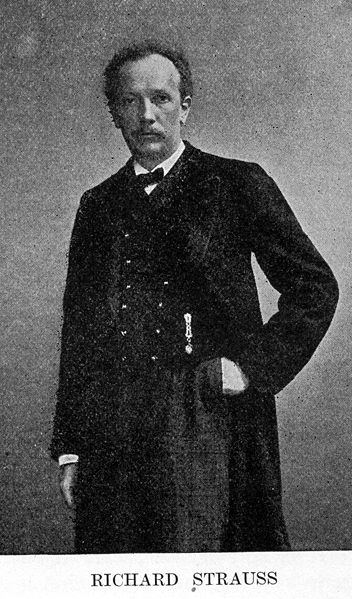
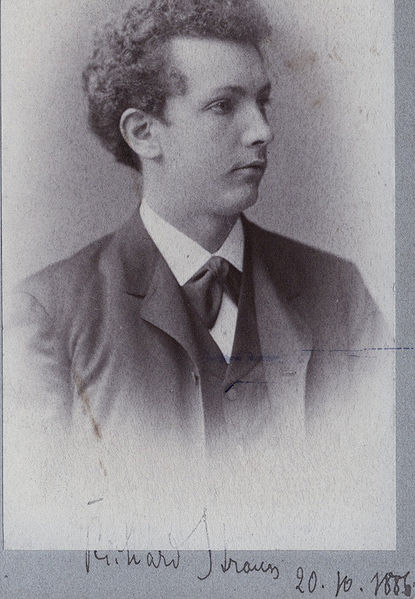
Richard Georg Strauss (11 June 1864 – 8 September 1949) was a leading German composer of the late Romantic and early modern eras. He is known for his operas, which include Der Rosenkavalier and Salome; his Lieder, especially his Four Last Songs; and his tone poems and other orchestral works, such as Death and Transfiguration, Till Eulenspiegel's Merry Pranks, Also sprach Zarathustra, An Alpine Symphony, and Metamorphosen. Strauss was also a prominent conductor throughout Germany and Austria.
Strauss, along with Gustav Mahler, represents the late flowering of German Romanticism after Richard Wagner, in which pioneering subtleties of orchestration are combined with an advanced harmonic style.
Strauss was born on 11 June 1864, in Munich, the son of Franz Strauss, who was the principal horn player at the Court Opera in Munich. In his youth, he received a thorough musical education from his father. He wrote his first composition at the age of six, and continued to write music almost until his death.
During his boyhood Strauss attended orchestra rehearsals of the Munich Court Orchestra, and he also received private instruction in music theory and orchestration from an assistant conductor there. In 1874 Strauss heard his first Wagner operas, Lohengrin and Tannhäuser. The influence of Wagner's music on Strauss's style was to be profound, but at first his musically conservative father forbade him to study it. Indeed, in the Strauss household, the music of Richard Wagner was viewed with deep suspicion, and it was not until the age of 16 that Strauss was able to obtain a score of Tristan und Isolde. In later life, Richard Strauss said that he deeply regretted the conservative hostility to Wagner's progressive works. Nevertheless, Strauss's father undoubtedly had a crucial influence on his son's developing taste, not least in Strauss's abiding love for the horn.
In 1882 he entered Munich University,
where he studied Philosophy and Art History, but not music. He left a
year later to go to Berlin, where he studied briefly before securing a
post as assistant conductor to Hans von Bülow, who had been enormously impressed by the young composer's Serenade
for wind instruments, composed when he was only 16 years of age.
Strauss learned the art of conducting by observing Bülow in rehearsal.
Bülow was very fond of the young man and decided that Strauss should be
his successor as conductor of the Meiningen orchestra when Bülow
resigned in 1885. Strauss's compositions at this time were indebted to
the style of Robert Schumann or Felix Mendelssohn,
true to his father's teachings. His remarkably mature Horn Concerto No.
1, Op. 11, is representative of this period and is a staple of modern
horn repertoire.
Richard Strauss married soprano Pauline de Ahna on 10 September 1894. She was famous for being irascible, garrulous, eccentric and outspoken, but the marriage, to all appearances, was essentially happy and she was a great source of inspiration to him. Throughout his life, from his earliest songs to the final Four Last Songs of 1948, he preferred the soprano voice to all others, and all his operas contain important soprano roles.
The Strausses had one son, Franz, in 1897. Franz married Alice von
Grab, a Jewish woman, in a Catholic ceremony in 1924. Franz and Alice
had two sons, Richard and Christian.
Some of Strauss's first compositions were solo and chamber works. These pieces include: early compositions for piano solo in a conservative harmonic style, many of which are lost; a string quartet (opus 2); a cello sonata; a piano quartet; Violin Sonata in E flat (1888); as well as a handful of late pieces.
After 1890 Strauss composed very infrequently for chamber groups, his
energies being almost completely absorbed with large scale orchestral
works and operas. Four of his chamber pieces are actually arrangements
of portions of his operas, including the Daphne - Etude for solo violin, and the string Sextet which is the overture to his final opera Capriccio. His last independent chamber work, an Allegretto in E for violin and piano, dates from 1940.
Strauss's style began to truly develop and change when, in 1885, he met Alexander Ritter, a noted composer and violinist, and the husband of one of Richard Wagner's nieces. It was Ritter who persuaded Strauss to abandon the conservative style of his youth, and begin writing tone poems. He also introduced Strauss to the essays of Richard Wagner and the writings of Arthur Schopenhauer. Strauss went on to conduct one of Ritter's operas, and at Strauss's request Ritter later wrote a poem describing the events depicted in Strauss's tone poem Death and Transfiguration.
The new influences from Ritter resulted in what is widely regarded as Strauss's first piece to show his mature personality, the tone poem Don Juan (1888), which displays a new kind of virtuosity in its bravura orchestral manner. Strauss went on to write a series of increasingly ambitious tone poems: Death and Transfiguration (Tod und Verklärung, 1889), Till Eulenspiegel's Merry Pranks (Till Eulenspiegels lustige Streiche, 1895), Thus Spoke Zarathustra (Also sprach Zarathustra, 1896), Don Quixote (1897), Ein Heldenleben (A Hero's Life, 1898), Sinfonia Domestica (Domestic Symphony, 1903) and An Alpine Symphony (Eine Alpensinfonie, 1911 – 1915). One commentator has observed of these works that "no orchestra could exist without his tone poems, written to celebrate the glories of the post - Wagnerian symphony orchestra."
Strauss's output of works for solo instrument or instruments with
orchestra was fairly extensive. The most famous include two concertos for horn, which are still part of the standard repertoire of most horn soloists; a Violin Concerto in D minor; the Burleske for piano and orchestra; the tone poem Don Quixote for cello, viola and orchestra; the well known late Oboe Concerto in D major; and the Duet - Concertino for bassoon, clarinet and orchestra, which was one of his last works (1947).
Around the end of the 19th century, Strauss turned his attention to opera. His first two attempts in the genre, Guntram (1894) and Feuersnot (1901), were controversial works: Guntram was the first significant critical failure of Strauss's career, and Feuersnot was considered obscene by some critics.
In 1905, Strauss produced Salome, based on the play by Oscar Wilde, which produced a passionate reaction from audiences. The premiere was a major success, with the artists taking more than 38 curtain calls. Many later performances of the opera were also successful, not only with the general public but also with Strauss's peers: Maurice Ravel said that Salome was "stupendous", and Mahler described it as "a live volcano, a subterranean fire". Strauss reputedly financed his house in Garmisch - Partenkirchen completely from the revenues generated by the opera.
Strauss's next opera was Elektra (1909), which took his use of dissonance even further, in particular with the Elektra chord. Elektra was also the first opera in which Strauss collaborated with the poet Hugo von Hofmannsthal. The two subsequently worked together on numerous occasions. For his later works with Hofmannsthal, Strauss moderated his harmonic language somewhat, which resulted in operas such as Der Rosenkavalier (1911) having great public success. Strauss continued to produce operas at regular intervals until 1942. With Hofmannsthal he created Ariadne auf Naxos (1912), Die Frau ohne Schatten (1918), Die ägyptische Helena (1927), and Arabella (1932). For Intermezzo (1923) Strauss provided his own libretto. Die schweigsame Frau (1934), was composed with Stefan Zweig as librettist; Friedenstag (1935 – 6) and Daphne (1937) both had a libretto by Joseph Gregor and Stefan Zweig; and Die Liebe der Danae (1940) was with Joseph Gregor. Strauss's final opera, Capriccio (1942), had a libretto by Clemens Krauss, although the genesis for it came from Stefan Zweig and Joseph Gregor.
All his life Strauss produced Lieder. The Four Last Songs are among his best known, along with "Zueignung", "Cäcilie", "Morgen!", "Allerseelen", and others. In 1948, Strauss wrote his last work, the masterful and haunting Four Last Songs for soprano and orchestra. He reportedly composed them with Kirsten Flagstad
in mind, and she gave the first performance, which was recorded.
Strauss's songs have always been popular with audiences and performers,
and are generally considered – along with many of his other compositions – to be masterpieces of the first rank.
In March 1933, when Richard Strauss was 68, Adolf Hitler and the Nazi Party rose to power. Strauss never joined the Nazi party, and studiously avoided Nazi forms of greeting. For reasons of expediency, however, he was initially drawn into cooperating with the early Nazi regime in the hope that Hitler – an ardent Wagnerian and music lover who had admired Strauss's work since viewing Salome in 1907 – would promote German art and culture. Strauss's need to protect his Jewish daughter - in - law and Jewish grandchildren also motivated his behavior, in addition to his determination to preserve and conduct the music of banned composers such as Mahler and Claude Debussy.
In 1933, Strauss wrote in his private notebook:
I consider the Streicher - Goebbels Jew baiting as a disgrace to German honor, as evidence of incompetence – the basest weapon of untalented, lazy mediocrity against a higher intelligence and greater talent.
Meanwhile, far from being an admirer of Strauss's work, Joseph Goebbels maintained expedient cordiality with Strauss only for a period. Goebbels wrote in his diary:
Unfortunately we still need him, but one day we shall have our own music and then we shall have no further need of this decadent neurotic.
Nevertheless, because of Strauss's international eminence, in November 1933 he was appointed to the post of president of the Reichsmusikkammer, the State Music Bureau. Strauss, who had lived through numerous political regimes and had no interest in politics, decided to accept the position but to remain apolitical, a decision which would eventually become untenable. He wrote to his family, "I made music under the Kaiser, and under Ebert. I'll survive under this one as well." In 1935 he wrote in his journal:
In November of 1933, the minister Goebbels nominated me president of the Reichsmusikkammer without obtaining my prior agreement. I was not consulted. I accepted this honorary office because I hoped that I would be able to do some good and prevent worse misfortunes, if from now onwards German musical life were going to be, as it was said, "reorganized" by amateurs and ignorant place - seekers.
Strauss privately scorned Goebbels and called him "a pipsqueak." Strauss wanted Goebbels' cooperation, however, in extending the German music copyright laws from 30 years to 50 years, so in 1933 Strauss dedicated an orchestral song, Das Bächlein ("The Little Brook") to him.
Strauss attempted to ignore Nazi bans on performances of works by Debussy, Mahler and Mendelssohn. He also continued to work on a comic opera, Die schweigsame Frau, with his Jewish friend and librettist Stefan Zweig. When the opera was premiered in Dresden in 1935, Strauss insisted that Zweig's name appear on the theatrical billing, much to the ire of the Nazi regime. Hitler and Goebbels avoided attending the opera, and it was halted after three performances and subsequently banned by the Third Reich.
On 17 June 1935, Strauss wrote a letter to Stefan Zweig, in which he stated:
Do you believe I am ever, in any of my actions, guided by the thought that I am 'German'? Do you suppose Mozart was consciously 'Aryan' when he composed? I recognize only two types of people: those who have talent and those who have none.
This letter to Zweig was intercepted by the Gestapo and sent to Hitler. Strauss was subsequently dismissed as Reichsmusikkammer president in 1935. The 1936 Berlin Summer Olympics nevertheless used Strauss's Olympische Hymne, which he had composed in 1934. Strauss's seeming relationship with the Nazis in the 1930s attracted criticism from some noted musicians, including Arturo Toscanini. When Strauss accepted the presidency of the Reichsmusikkammer in 1933, Toscanini had said, "To Strauss the composer I take off my hat; to Strauss the man I put it back on again." Much of Strauss's motivation in his conduct during the Third Reich was, however, to protect his Jewish daughter - in - law Alice and his Jewish grandchildren from persecution. Both of his grandsons were bullied at school, but Strauss used his considerable influence to prevent the boys or their mother from being sent to concentration camps.
In 1938, when the entire nation was preparing for war, Strauss created Friedenstag (Peace Day), a one act opera set in a besieged fortress during the Thirty Years War.
The work is essentially a hymn to peace and a thinly veiled criticism
of the Third Reich. With its contrasts between freedom and enslavement,
war and peace, light and dark, this work has a close affinity with Beethoven's Fidelio. Productions of the opera ceased shortly after the outbreak of war in 1939.
When his Jewish daughter - in - law Alice was placed under house arrest in Garmisch - Partenkirchen in 1938, Strauss used his connections in Berlin, including the Berlin intendant Heinz Tietjen, to secure her safety. He drove to the Theresienstadt concentration camp in order to argue, albeit unsuccessfully, for the release of his son Franz's Jewish mother - in - law, Marie von Grab. Strauss also wrote several letters to the SS pleading for the release of her children who were also held in camps; his letters were ignored.
In 1942, Strauss moved with his family back to Vienna, where Alice and her children could be protected by Baldur von Schirach, the Gauleiter
of Vienna. Strauss was unable, however, to protect his Jewish relatives
completely; in early 1944, while Strauss was away, Alice and his son
Franz were abducted by the Gestapo and imprisoned for two nights. Only
Strauss's personal intervention at this point was able to save them, and
he was able to take the two of them back to Garmisch, where they remained under house arrest until the end of the war.
Strauss completed the composition of Metamorphosen, a work for 23 solo strings, in 1945. The title and inspiration for the work comes from a profoundly self examining poem by Goethe, which Strauss had considered setting as a choral work. Generally regarded as one of the masterpieces of the string repertoire, Metamorphosen contains Strauss's most sustained outpouring of tragic emotion. Conceived and written during the blackest days of World War II, the piece is commonly seen as expression of Strauss's mourning of, among other things, the destruction of German culture – including the bombing of every great opera house in the nation; although this view may not be exactly accurate. At the end of the war, Strauss wrote in his private diary:
The most terrible period of human history is at an end, the twelve year reign of bestiality, ignorance and anti - culture under the greatest criminals, during which Germany's 2000 years of cultural evolution met its doom.
In April 1945, Strauss was apprehended by American soldiers at his
Garmisch estate. As he descended the staircase he announced to
Lieutenant Milton Weiss of the U.S. Army, "I am Richard Strauss, the
composer of Rosenkavalier and Salome." Lt. Weiss, who, as
it happened, was also a musician, nodded in recognition. An 'Off Limits'
sign was subsequently placed on the lawn to protect Strauss. The American oboist John de Lancie,
who knew Strauss's orchestral writing for oboe thoroughly, was in the
U.S. Army unit which occupied the area; he asked Strauss to compose an
oboe concerto. Initially dismissive of the idea, Strauss completed this
late masterpiece, his Oboe Concerto, before the end of the year.
The metaphor "Indian Summer" is often used by journalists, biographers, and music critics to describe Strauss's late upsurge of genius from 1942 through the end of his life. The horrifying events of World War II seemed to bring the composer – who had grown old, tired, and a little jaded – into focus. The major works of the last years of Strauss's life, written in his late 70s and 80s, have a luminosity which matches anything he had composed earlier in his life, and they surpass most of them in emotional depth. These pieces include, among others, his Horn Concerto No. 2, Metamorphosen, his Oboe Concerto, and his masterful and haunting Four Last Songs.
The Four Last Songs, composed shortly before Strauss's death, deal poetically with the subject of dying. The last, "At Sunset" (Im Abendrot),
ends with the line "Is this perhaps death?" The question is not
answered in words, but instead Strauss quotes the "transfiguration
theme" from his earlier tone poem, Death and Transfiguration – symbolizing the transfiguration and fulfillment of the soul after death.
Richard Strauss died at the age of 85 on 8 September 1949, in Garmisch - Partenkirchen, Germany. Georg Solti, who had arranged Strauss's 85th birthday celebration, also directed an orchestra during Strauss's burial. During the singing of the famous trio from Rosenkavalier, Solti described how "each singer broke down in tears and dropped out of the ensemble, but they recovered themselves and we all ended together." Strauss's wife, Paulina, died eight months later, on 13 May 1950, at the age of 88.
During his lifetime Strauss was considered the greatest composer of the first half of the 20th century, and his music had a profound influence on the development of 20th century music. There were few 20th century composers who compared with Strauss in terms of orchestral imagination, and no composer since Wagner made a more significant contribution to the history of opera. And Strauss's late works, modeled on "the divine Mozart at the end of a life full of thankfulness," are perhaps the most remarkable works by any octogenarian composer.
Strauss himself declared in 1947 with characteristic
self deprecation, "I may not be a first rate composer, but I am a
first - class second - rate composer." The Canadian pianist Glenn Gould described Strauss in 1962 as "the greatest musical figure who has lived in this century."
Strauss, as conductor, made a large number of recordings, both of his own music as well as music by German and Austrian composers.
His 1929 performances of Till Eulenspiegel and Don Juan with the Berlin State Opera Orchestra have long been considered the best of his early electrical recordings; even the original 78 rpm discs had superior sound for their time, and the performances were top notch and quite exciting at times, despite a noticeable mistake by the Horn soloist in the famous opening passage of Till Eulenspiegel.
One of the more interesting of Strauss's recordings is perhaps the first complete performance of his An Alpine Symphony, made in 1941 and later released by EMI, because Strauss used the full complement of percussion instruments required in this spectacular symphony. The intensity of the performance rivaled that of the digital recording Herbert von Karajan made many years later with the Berlin Philharmonic.
Music critic Harold C. Schonberg in The Great Conductors (1967), says that while Strauss was a very fine conductor, he often put scant effort into his recordings. Schonberg focused primarily on Strauss's recordings of Mozart's Symphony No. 40 in G minor and Beethoven's Symphony No. 7, as well as noting that Strauss played a breakneck version of Beethoven's 9th Symphony in about 45 minutes. Concerning the Beethoven 7th symphony, Schonberg wrote, "There is almost never a ritard or a change in expression or nuance. The slow movement is almost as fast as the following vivace; and the last movement, with a big cut in it, is finished in 4 minutes, 25 seconds. (It should run between 7 and 8 minutes.)" Schonberg also complained that the Mozart symphony had "no force, no charm, no inflection, with a metronomic rigidity."
Peter Gutmann's 1994 review for ClassicalNotes.com says the performances of the Beethoven 5th and 7th symphonies, as well as Mozart's last three symphonies, are actually quite good, even if they are sometimes unconventional. Gutman wrote:
The Koch CDs represent all of Strauss's recordings of works by other composers. The best of his readings of his own famous tone poems and other music are collected on DGG 429 925-2, 3 CDs. It is true, as the critics suggest, that the readings forego overt emotion, but what emerges instead is a solid sense of structure, letting the music speak convincingly for itself. It is also true that Strauss's tempos are generally swift, but this, too, contributes to the structural cohesion and in any event is fully in keeping with our modern outlook in which speed is a virtue and attention spans are defined more by MTV clips and news sound bites than by evenings at the opera and thousand page novels.
Koch Legacy has also released Strauss's recordings of overtures by Gluck, Carl Maria von Weber, Peter Cornelius and Wagner. The preference for German and Austrian composers in Germany in the 1920s through the 1940s was typical of the German nationalism that existed after World War I. Strauss clearly capitalized on national pride for the great German speaking composers.
There were many other recordings, including some taken from radio broadcasts and concerts, during the 1930s and early 1940s. The sheer volume of recorded performances would undoubtedly yield some definitive performances from a very capable and rather forward looking conductor.
In 1944, Strauss celebrated his 80th birthday and conducted the Vienna Philharmonic in recordings of his own major orchestral works, as well as his seldom heard Schlagobers ("Whipped Cream") ballet music. Some find more feeling in these performances than in Strauss's earlier recordings, which were recorded on the Magnetophon tape recording equipment. Vanguard Records later issued the recordings on LPs. Some of these recordings have been reissued on CD by Preiser and are of remarkable fidelity.
Strauss also made live recording player piano music rolls for the Hupfeld system, all of which survive today.
Richard Strauss was the composer of the music on the first CD to be
commercially released: Deutsche Grammophon's 1983 release of their 1980
recording of Herbert von Karajan conducting the Alpine Symphony.
